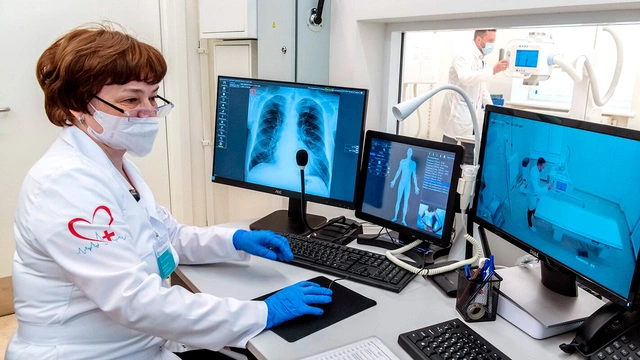The consequences of coronavirus may be more dangerous than its acute phase. According to statistics, almost half of recovered patients experience changes in the lungs after infection. And re-hospitalization after discharge and mortality of elderly patients occurs in approximately 27% of cases. Such data were announced at the All-Russian conference “Covid-19: Expert experience of working in a pandemic. Everything about diagnosis, prevention, treatment, rehabilitation of patients.”
 35668
35668
What is the danger of post-Covid syndrome?
Today, doctors have to reconsider the treatment tactics for post-Covid syndrome in favor of antifibrotic therapy, Professor, Academician of the Russian Academy of Sciences Alexander Chuchalin shared with his colleagues. The post-Covid period in a patient is accompanied by a number of changes in the lungs – they are diagnosed in approximately half of patients who have had Covid. These processes are characterized by remodeling of the lung tissue, with the participation of the vessels of the pulmonary circulation, and the recovery process is disrupted. Collagen is deposited in connective tissue, which leads to the formation of fibrotic changes. The main manifestation of these post-Covid changes in lung tissue is shortness of breath, the intensity of which increases with physical activity.
“At this moment, a large amount of hyaluronic acid accumulates in the lungs, which leads to swelling. There is a disruption in the regulation of water-electrolyte metabolism. It is reduced in volume, gas exchange functions are disrupted, and a scar is formed. The lung begins to resemble burnt rubber,” noted Alexander Chuchalin.
According to Tatyana Nikolaevna Bilichenko, a professor and pulmonologist at the Research Institute of Pulmonology of the Federal Medical and Biological Agency of Russia, patients with severe COVID-19 at the recovery stage have a high chance of developing post-Covid syndrome due to systemic organ damage and a long-lasting inflammatory process. Therefore, clinical examination in the post-Covid period must necessarily include studies aimed at assessing the inflammatory process. The 6-minute walk test is also important, helping to monitor the patient’s tolerance to physical activity during treatment. If the level of saturation while walking decreases by more than 4%, it can be assumed that the current methods of restoring pulmonary function are insufficient and additional therapy is required.
New approaches to restoring the lungs after Covid
Drugs containing the enzyme hyaluronidase are today regarded by doctors as promising for the treatment of patients with residual changes in the lungs after Covid. Scientists explain this by the fact that hyaluronidase is able to enhance the diffusion of oxygen in the tissue, due to which the patient recovers faster. The discovery of such properties of the enzyme can be considered a real achievement of science and medicine.
Professor of the Department of Phthisiology and Pulmonology of the Medical Faculty of the Moscow State Medical University named after A.I. Evdokimov, Doctor of Medical Sciences Sergei Babak told us what the strategy for drug therapy for post-Covid patients should be based on. It is important to remember that shortness of breath and fatigue persist in 52.4%, and difficulty breathing in 47.6% of post-Covid patients. The expert identified 5 positions that practitioners should focus on. This includes improving ventilation and gas exchange, providing nutritional support to the patient, increasing his physical endurance, overcoming external and internal “stress agents,” and correcting sleep disorders.
Professor Sergei Babak spoke about the original domestic drug “Longidaza®”, which contains bovhyaluronidase on an azoximer carrier, which allows the drug to retain its activity for a long time.
“The DISSOLVE study to study the activity of Longidase in post-Covid patients showed that 58.4% of patients had a positive effect, and among them in 44.6% it exceeded 10%1. The second most important result was the improvement in gas exchange, assessed during the 6-minute walk test. The result is impressive: a significant improvement in indicators (by 30 percent or more) was observed both on the 75th day and on the 180th day of observation, which clinically means the almost complete elimination of shortness of breath both at rest and during exercise in this category of patients.
< h2>Restoration of lung tissue and elimination of respiratory symptoms
Professor Sergei Babak shared the results of his own experience in prescribing antifibrotic therapy to outpatients of the Center for Respiratory Medicine. He demonstrated a clinical example of a 44-year-old man with obvious radiographic interstitial changes with impaired diffusion capacity of the lungs, which were eliminated by complex outpatient therapy including bovhyaluronidase azoximer. An assessment of the X-ray and functional picture in the second month of therapy revealed the restoration of the structure and function of the lung tissue, an increase in the vital capacity of the lungs by +810 ml, and the diffusion capacity of the lungs up to 100% of the required values. “Clinically, this was characterized by the complete elimination of respiratory symptoms, especially shortness of breath during physical activity,” noted Professor Sergei Babak.
Data on the use of Longidase were also presented at the conference, which showed that in the first 4 days of the course the drug significantly softened the respiratory therapy regimens in a seriously ill patient, and after 9 days the patient’s health improved so much that he was transferred from the intensive care unit to the somatic department, where he already managed without oxygen support. At discharge, the patient's saturation level was close to normal. And doctors assessed the full effect of this therapy after 2 months during the patient’s follow-up visit. By that time, the lung tissue had almost completely recovered, which indicates very good clinical dynamics.
Links:
1. Statistical report of the DISSOLVE v1.0 study dated 09/20/2021
